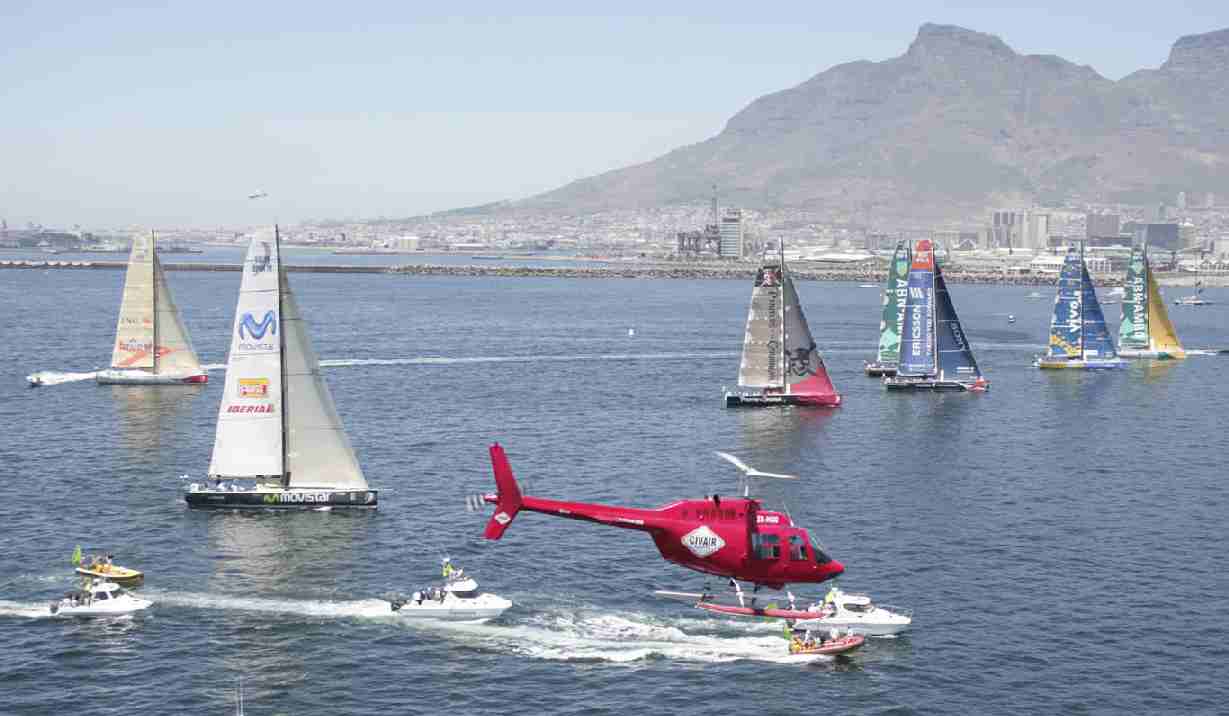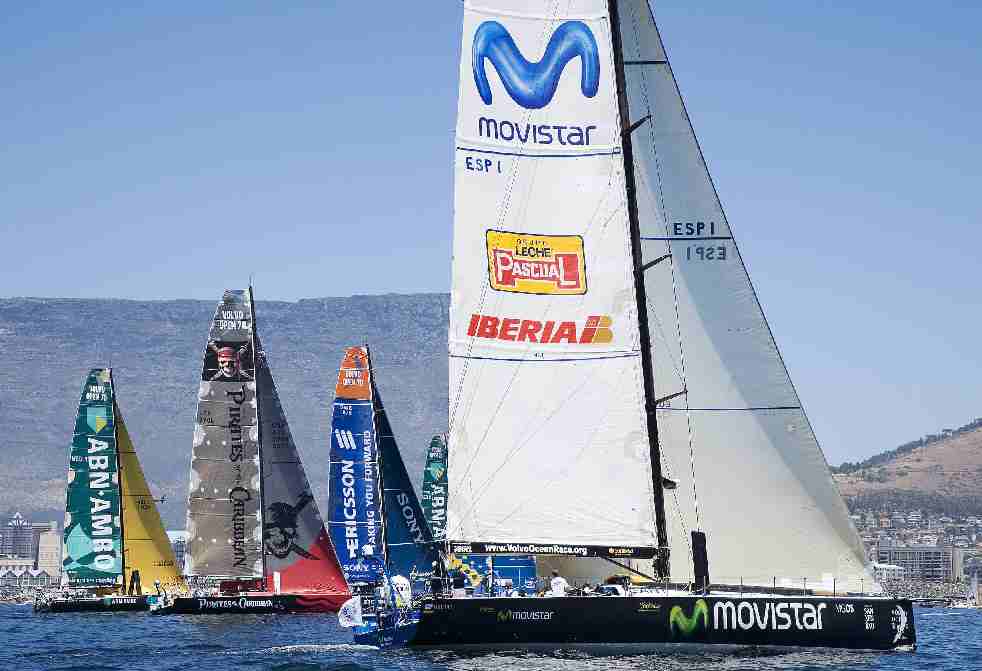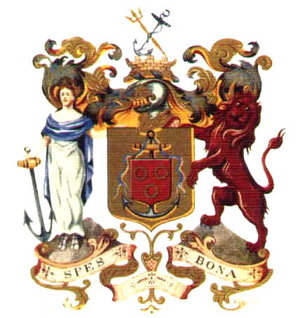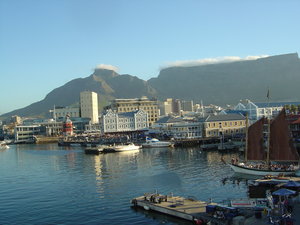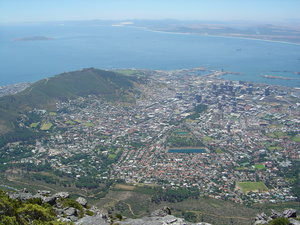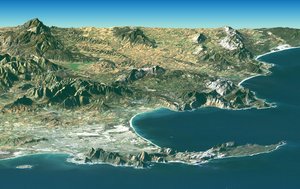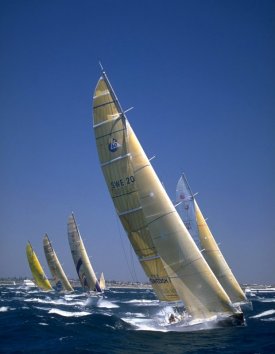|
THE VOLVO OCEAN RACE 2005-2006 - CAPE TOWN |
||||||||||||||||||||||||||||||||||||||||||
|
HOME SITE INDEX CATAMARAN HULL SOLAR PANELS ELECTRIC MOTORS BATTERIES CREW EXPEDITION SPONSORS |
||||||||||||||||||||||||||||||||||||||||||
|
Positions
after the 11:00 report are as follows: 1st
MOVISTAR ( 2nd
ABN AMRO One (HOL) + 3rd
PIRATES OF THE CARIBBEAN (USA) + 4th
ABN AMRO Two (HOL) + 5th
ING REAL ESTATE BRUNEL (AUS), + 6th
Brasil 1 (BRA), + 7th
ERICSSON (SWE), +
After
three days of competition, the Spanish Round the World boat
"movistar"
remains in first place on the second leg
of the Volvo Ocean Race from Throughout
the night, the Spanish boat has seen how the winds carrying the
rest of the fleet, situated further south west, have enabled
them to reduce the distance between them and the "movistar",
which is headed for the ?Roaring Forties? at 13 knots, while the
American and Dutch teams in ?Pirates of the Caribbean and ?ABN
AMRO One? and ?Two? are already sailing at over 20 knots. The
Spanish team?s hopes of maintaining the lead over the next few
hours lies in reaching the area of the 42nd parallel
as soon as possible (they have "movistar"
skipper, Bouwe Bekking, told us this morning how things had been
these last few hours with the strong head winds dropping as they
moved into areas of lighter winds: "What
a difference from last night!" The
difference between the early hours of Wednesday and Thursday was
evident from what he described: "At
this time yesterday, we had 30 knots, two reefs in the main sail
and a small jib. Right now, we are doing five knots, but we can
still manage to do seven knots of speed, despite the
difficulties". With
regard to the Swedish and Brazilian teams returning to shore, he
remarked, "the sad
news about Ericsson and Brasil1 reminds me of the first leg and
there has been lots of speculation aboard, about how this could
have happened to them. Now they are in the same situation as we
were just over a month and a half ago, headed back to port and
immensely disappointed. From the ?movistar?,
we wish you a good journey and good luck with the repairs". In
light of what has happened in the fleet, the "movistar"
crew wanted to check that everything was working perfectly
"of course, we too
have checked our hydraulics, but as we control the cylinders in
a different way, I am not worried".
"We adjusted
the valves that release the pressure on the engine collector and
we check the pressures with external indicators, that way, at a
certain pressure, the cylinders will release the load. In other
words, the keel will move towards the centre, taking the
pressure off the whole system and the structure, but at the
expense of performance". Bekking
explains how the crew members in charge of hydraulics and
electrics checked everything "Pepe
and Chris examined the whole system, everything seems to be
fine, but the horror of having to return to port is constantly
on my mind, if something goes wrong. One of the things that
really bothers me is that I can?t call a hydraulics expert who
could explain why this has happened to the Ericsson, but the
rules do not allow that. I?ll be sure to put this to the Volvo
organisers as soon as we get to The
foibles of the regulations really do not satisfy the skipper of
the "movistar".
"You can go
back to port and have all the outside help you like, but you can
not make a call or send an e-mail. There is no excuse, I should
have thought about it before". The
pressure of being in charge aboard has not allowed him to enjoy
the 72 hours that they have been the leader: "Even
bearing in mind that we are doing well, I am not really enjoying
this, as the business of the hydraulic pistons is bothering me".
The rest of the crew, on the other hand, is really happy: "Incredibly,
the boys on deck don?t seem to be too bothered by this, a big
difference between being the skipper and being one of the crew.
They just carry on with their work, doing the best they can to
stay in first place". On
tactics, Bekking explains what he and the navigator are going
through in these hours: "Capey
?Andrew Cape? and I
spend most of the time at the navigation table, examining
charts, talking about all the options and how we will position
the boat in comparison with our rivals" "Yesterday
afternoon, we left this bloody place for the first time, as we
have both been on standby for the sail changes since the
beginning of the leg". After
three days, today has been the first day that they have really
managed to rest "It
looks like tonight will be the first comfortable night?s sleep
in a sleeping bag, you only have to look at Capey in his bunk...
fully equipped with all his clothes on, maybe he?s too lazy to
take them off, but, if necessary, he?s ready in a couple of
seconds". Aboard
the "movistar"
last night, they were already foreseeing what has started to
happen with the fleet "the
next information about positions will be very interesting. We
all have to cross an area of high pressure and we think that we
have taken the right position and that we can do it a bit closer
than the rest, but even they will gain speed in the next few
days, as a front will come up on them from behind, so in
general, we expect all the boats will re-group and any of them
could lead the group".
Laura
Naranjo
Cape
Town (South Africa). 4th of January, 2005
Cape Town (South Africa), December 16, 2005. Visitors
at the V&A Waterfront in Cape Town port came across a new
tenant at Shosholoza, base of the local America’s Cup team.
The “movistar” is already resting on her cradle on South
African soil after her long journey from Puerto Real, Cadiz, and
is eager to hit the water again. After
a long night of logistics work to complete unloading, set-up ad
transport of the “movistar” from the commercial dock to the
team base, the shore team started preparations yesterday for the
final tune-up before resuming ocean trials in Cape Town waters. “It
is a relief to finally have the boat here- said
skipper Bouwe Bekking during the team’s meeting yesterday. –
We worked hard at Portimao
and thanks to everyone’s efforts, the boat has arrived in Cape
Town 11 days before the start of the inshore regatta; that gives
us plenty of time to sail before going back to the fray”. “During
transport from Portimao to Cadiz, the conditions were not
appropriate for sailing, so we will test the boat here for the
first time. However, after seeing the result of the repairs
done, I am quite confident that she is as fine as ever, or even
better. We will be pushing her to the limit when we leave Cape
Town next January 2, so that confidence will come in handy”. Back
to the water on Sunday During
the daily review of the schedule for the next days, Bekking
confirmed to the crew that they will be sailing this weekend. “If
everything goes as planned, we hope to be ready to return to the
water on Sunday. After that, we will have to sail as much as
possible and push the boat to her limits, especially against the
waves. It will be a busy schedule that will include offshore
sailing”. The team’s plans for the next weeks focus on sailing, but also on physical training. “We will train hard until Sunday – says “movistar”’s trimmer Xabi Fernández -, including jogging early in the morning and a few
Cape Town (Afrikaans: Kaapstad; Xhosa: eKapa or SaseKapa) is the third most populous city in South Africa. It is the legislative capital of South Africa, as well as capital of the Western Cape province. Cape Town is famous for its natural harbour, as well as its location near the Cape of Good Hope. Its central area is dominated by Table Mountain, so named after its flat top. Cape Town is located at 33°55′ S 18°27′ E.
Cape Town coat of arms
Cape Town is the tourism capital of South Africa, receiving the largest number of tourists of any South African city.
The area is also famous for its unique plant life: fynbos (an Afrikaans word meaning "fine bush"), a shrubby vegetation type similar to other winter rainfall shrublands, in which proteas are prominent and characteristic and which occurs nowhere else but the Cape coastal belt, the adjacent mountains and some isolated inland mountain tops. Fire is a necessary stage in the lives of almost all fynbos plants. In readiness for fire, most proteas retain their seeds on the bush for at least one year, a habit known as serotiny. They do this in structures which resemble the original flowerheads. In some species these structures are strikingly beautiful and long-lasting, which accounts for their use in dried floral arrangements.
Lastly, it is famous for the fine wines produced in the areas of Stellenbosch, Paarl and Robertson. When leaving Cape Town, you first pass the suburbs and Cape Town International Airport. After getting over the mountains you enter the Karoo in the north-east or the coast regions in the north and east.
CAPE TOWN HISTORY
One of 4 waterfront harbours in Cape Town area
The area today known as Cape Town was settled by the San and Khoikhoi, collectively known as the Khoisan, long before the Dutch East India Company (Vereenigde Oost-Indische Compagnie; VOC) established a supply depot in Cape Town in 1652. By and large the indigenous people refused to deal with the Dutch, so the VOC imported slaves from Madagascar, India, Ceylon, Malaya, and Indonesia to deal with the colony's chronic labour shortage. There was also a shortage of women in the colony, so the Europeans exploited the female slaves for both labour and sex. In time the slaves also mixed with the Khoisan. The offspring of these unions formed the basis of sections of today's Cape Coloured population and also helps explain the unique character of the city's Cape Malay population.
During 150-odd years of Dutch rule, Kaapstad, as the Cape settlement became known, thrived and gained a wider reputation as the "Tavern of the Seas", a riotous port used by every sailor travelling between Europe and the Orient. But, by the end of the 18th century, the VOC was nearly bankrupt, making Cape Town an easy target for British imperialist interests in the region. Following the British defeat of the Dutch in 1806 at Bloubergstrand, 25 kilometres north of Cape Town, the colony was ceded to the Crown on 13 August 1814. The slave trade was abolished in 1808, and all slaves were emancipated in 1833.
The discovery and exploitation of diamonds and gold in the Highveld region of South Africa in the 1870s and 1880s led to rapid changes. Cape Town was soon no longer the single dominant metropolis in the country, but as a major port it too was a beneficiary of the mineral wealth that laid the foundation for an industrial society. The same wealth led to imperialist dreams of grandeur on the part of Cecil John Rhodes, the premier of the Cape Colony in , who had made his millions at the head of De Beers Consolidated Mines.
In 1901 the government introduced racial segregation: Africans were moved to two locations, one near the docks and the other at Ndabeni on the western flank of Table Mountain. This was the start of what would later develop into the townships of the Cape Flats. In 1948, the National Party stood for election on its policy of apartheid and won. In a series of bitter court and constitutional battles, the limited rights of blacks and coloureds to vote in the Cape were removed, and the apparatus of apartheid was erected. This resulted in whole communities being uprooted and cast out to the Cape Flats.
The government tried for decades to eradicate squatter towns, such as Crossroads, which were the focal point for black resistance to the apartheid regime. In the last attempt between May and June 1986, an estimated 70,000 people were driven from their homes and hundreds were killed. Even this brutal attack was unsuccessful in eradicating the towns, and the government accepted the inevitable and began to upgrade conditions.
Hours after being released from prison on 11 February 1990, Nelson Mandela made his first public speech in decades from the balcony of Cape Town's City Hall, heralding the beginning of a new era for South Africa. Much has improved in Cape Town since; property prices are increasing greatly and the city centre is becoming safer, with the development of loft-style apartments in grand old structures such as the Old Mutual Building and the Board of Executors building. Full integration of Cape Town's mixed population, however, remains a long way off, if it is achievable at all. The African National Congress (ANC) and the New National Party (NNP) are working together on the City Council, which is headed up by mayor Nomaindia Mfeketo, a black woman. Meanwhile the vast majority of Capetonians who live in the Cape Flats are still split along race lines and suffer horrendous economic, social, and health problems. Cape Town is dealing with the major problems like AIDS and violent drug-related crime in these areas.
Table Mountain view of Robben Island, Cape Town
Government
Cape Town is governed by a 200-member city council, who answer to a 28-member executive council. This in turn is presided over by a city manager and an executive mayor. The current mayor is Nomaindia Mfeketo and the current city manager is Wallace Mgoqi.
Demographics
As of the census of 2001, there are 2,893,251 people and 759,767 households residing in the city. The population density is 1,158/km². The household density is 304/km². The racial makeup of the city is 31.68% Black African, 48.13% Coloured, 1.43% Indian/Asian, and 18.75% White.
16.0% of all households are made up of individuals. The average household size is 3.81. In the city the population is spread out with 26.6% under the age of 15, 20.0% from 15 to 24, 33.4% from 25 to 44, 15.0% from 45 to 64, and 5.0% who are 65 years of age or older. The median age is 26 years. For every 100 females there are 92.4 males. For every 100 females age 18 and over, there are 89.3 males.
In the city 41.4% of residents speak Afrikaans at home, 27.9% speak English, 0.0% speak Ndebele, 28.7% speak Xhosa, 0.3% speak Zulu, 0.0% speak Sepedi, 0.7% speak Sesotho, 0.1% speak Setswana, 0.0% speak SiSwati, 0.0% speak Tshivenda, and 0.0% speak Xitsonga. 0.7% of the population speaks a non-official language at home. 76.6% of residents are Christian, 10.7% have no religion, 9.7% are Muslim, 0.5% are Jewish, and 0.2% are Hindu. 2.3% have other or undetermined beliefs.
4.2% of residents aged 20 and over have received no schooling, 11.8% have had some primary school, 7.1% have completed only primary school, 38.9% have had some high school education, 25.4% have finished only high school, and 12.6% have an education higher than the high school level. Overall, 38.0% of residents have completed high school. 68.6% of housing units have a telephone and/or cell-phone in the dwelling, 29.5% have access to a phone nearby, and 1.9% have access that is not nearby or no access. 87.4% of households have a flush or chemical toilet. 94.4% have refuse removed by the municipality at least once a week and 1.4% have no rubbish disposal. 69.3% have running water inside their dwelling, 84.4% have running water on their property, and 98.7% have access to running water. 80.1% of households use electricity for cooking, 75.0% for heating, and 88.8% for lighting. 80.7% of households have a radio, 77.0% have a television, 21.3% own a computer, 76.4% have a refrigerator, and 45.5% have a cell-phone.
19.4% of the population aged 15-65 is unemployed. Of the unemployed persons, 58.3% are Black African, 38.1% are Coloured, 0.5% are Indian/Asian, and 3.1% are White. 34.8% of Black Africans are unemployed, 15.8% of Coloureds, 7.1% of Indians/Asians, and 3.1% of Whites.
The median annual income of working adults aged 15-65 is R 25,774 ($3,874). Males have a median annual income of R 28,406 ($4,270) versus R 22,265 ($3,347) for females. The median annual income by race is R 13,471 ($2,025) for Black Africans, R 23,012 ($3,459) for Coloureds, R 44,233 ($6,648) for Indians/Asians, and R 70,380 ($10,579) for Whites. The annual income distribution in Cape Town is:
Statistics South Africa Census 2001
Cape Town from space (NASA)
Tourism
Cape Town is a popular tourist destination, offering the visitor a wide variety of activities such as water sports (including diving, surfing and sailing), angling, wine-tasting, shopping, scenic drives, mountaineering, hiking, kite-flying, hang-gliding and parasailing, and bird- and whale-watching. Cruises around the Cape of Good Hope are also popular among tourists.
The most popular time for visitors is the summer from October to March, though some visitors from more temperate climates might find the height of summer (December and January) uncomfortably hot. The city also becomes very crowded then as the local holidaymakers descend on the city for their summer school holidays. The most popular tourist attractions are, in order of popularity: The Victoria & Alfred waterfront, a popular shopping venue with thousands of shops, fine hotels, a world-class marina and an aquarium; Table Mountain, which can be accessed either by walking or a cable car; Signal Hill with the Noon gun, Cape Point; and Boulders Beach, home to a colony of penguins. The Cape Peninsula and the region around Cape Town offer wonderful walking and hiking opportunities from right in the middle of the city where the mountains can be accessed very easily (such as Lion's Head and Devil's Peak) to further afield in the surrounding mountain ranges.
Boat trips can be undertaken from the Victoria & Alfred marina to visit Robben Island. It is a well known spot for windsurfers/kitesurfing, mainly in the summer seasons (September to February).
Other boat trips can be undertaken from Simonstown (the main South African naval base) on the False Bay coast to Seal Island and Cape Point and from Hout Bay, a fishing harbour on the Atlantic coast of the Cape Peninsula, to Duiker Island which has a population of 6000 seals in breeding season dropping to 1500 seals in the off season.
One of the world's largest population of Southern Right Whales occurs in the breeding season (August to November) and can be found off the coast of the Cape Peninsula and the surrounding coast of the Western Cape. Many local observation points allow sightings from close by. Hermanus is the most famous and whales often come within 100yds of the shore there but they can be seen in False Bay, as can Bryde's Whale, which occur all year. Heaviside's Dolphin is endemic to the area and can be seen from the coast north of Cape Town, especially from Lambert's Bay where boat trips run to view them. Dusky Dolphin can be seen along the same stretch of coast but is more active with a swept back dorsal fin which is distinctly two-toned. This species may be seen from the ferry to Robben Island.
Local wineries offer tastings and informative tours are available. August and September are the best time to visit the west coast, because the desert comes to life after the winter rains and the wild flowers bloom in profusion.
A cable car system takes visitors to the top of Table Mountain, though it only operates in good weather as gale-force winds can make it dangerous or clouds can obscure the view from the summit. The operating status (open or closed) of the cable car is posted on a signboard at Kloof Nek.
Sports teams and stadiums
Cape Town boasts two soccer teams in the Premier League, Santos (based in Athlone) and Ajax Cape Town (based in Parow).
The Cape Town suburb of Newlands is the home of the Western Province rugby team, one of the powerhouses in South African rugby, as well as Western Province cricket. Newlands is also home to one of South Africa's four Super 12 rugby franchises, the Stormers. The clement weather of the region allows open air sports all year round. Apart from team sports, golf and tennis are very popular and facilities for these exist all over the city. Conditions for scuba diving, surfing and both kite and board sailing are world class and attract many foreign tourists.
Transport
Cape Town International Airport is the second biggest airport in South Africa and a major gateway for travellers to the Cape Region. It offers a number of International flights to destinations in Africa, Europe, Asia and North America. Nearly all commercial airports in South Africa are served from here.
Further education in Cape Town
Both the University of Cape Town and the University of the Western Cape are located within the Cape Town metropole, while Stellenbosch University is within a 50 km reach. There is also the Cape Peninsula University of Technology, formed after the merging of the Cape Technikon and the Peninsula Technikon.
LINKS
ABOUT THE VOLVO OCEAN RACE
The Volvo Ocean Race is the ultimate mix of world class sporting competition and on the edge adventure. It takes 8 months, covers 31,000 nautical miles of treacherous seas over 9 legs, in the process visiting 10 ports around the world.
The teams comprise professional sportsmen and women at the top of their game. The race requires their utmost skill, physical endurance and competitive spirit as they race from continent to continent in an easterly direction around the world.
Round The World Yacht Race 2005 - 2006:
The Volvo Ocean Race is a marathon event. For nine months, world-class racers battle each other around the globe over some 32,700 miles (52,600 kilometers). Participants spend weeks at a time driving their boats to the limit 24 hours a day. They sacrifice sleep, privacy, fresh food, and other comforts to win each leg. But what happens when they reach the next port of call?
The race doesn't stop-it just shifts gears. Weary sailors get a chance to rest and prepare for the next leg, while the shore crew swings into action. After weeks of demanding action, and a spartan existence at sea, the first things these exhausted sailors crave are basic human needs. The event will start on November 5, 2005 with an inport race in Sanxenxo, Galicia, Spain.
The race track will continue to follow the traditional route of the old clipper ships, sailing around the world with the prevailing winds. An exciting new feature introduced for this event is a number of scoring gates and pit stops around the world, where the fleet will be able to score points, which will count towards the final score.
|
||||||||||||||||||||||||||||||||||||||||||
|
